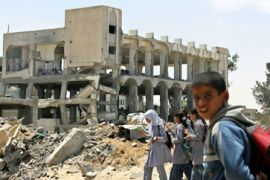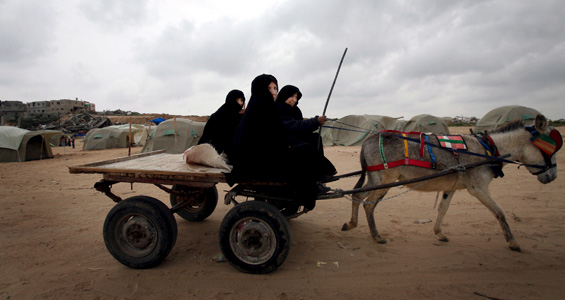
Reporter’s view: ‘The same story’
Sherine Tadros describes the challenges involved in keeping the Gaza story alive.
 |
| Israel’s war on Gaza left many Gazans homeless [EPA] |
‘It’s the same story’ – a phrase I often use, as do my editors in Doha. Either they are trying to convince me to do a story that I feel I have already done, or I am convincing them of a story that they feel I have already covered.
How do you cover a tightening siege? Essentially it is the same story about shortages that you did last month, but this month it is a little worse.
But the devil is in the detail, and the details are what Israel is so good at changing without anyone really noticing.
And then there are the UN and NGO reports that keep coming out about Israel’s war crimes – testimonies from Gaza that have humanitarians reeling.
Again, it is the same problem – each report is important, each reveals a different facet of what Israel did here, but essentially the story is about brutal force used against a civilian population and the failure to distinguish between the people and military targets.
The question is one of deliberate action, the possibility of using other methods but a decision by the military to make the people suffer.
We can tell that story through the experiences of people in Gaza until we are blue in the face, but the real question is will any of these alleged war criminals be brought to account? And how do we as journalists keep the Gaza story alive in the face of an international community that is growing increasingly disinterested?
Technical nightmare
Our approach as a channel during the war on Gaza at least was to tell you what the people were telling us, unfiltered.
It is difficult to keep the attention of a global audience with no particular face, no precise profile, but we boiled it down to the lowest common denominator – the human being and the fear each person was feeling every second of every day of Israel’s onslaught.
That is what we delivered as a network to our audience, but there were difficulties along the way.
Working in Gaza is a technical nightmare – Israeli drones hang above the territory watching down on a population that can go nowhere anyway.
They interrupt signals and satellites so even when there is enough electricity to watch television, you cannot actually watch anything for more than a few minutes without the picture getting scrambled.
When you hear people speak about Israel controlling every facet of the life of a Gazan, it is not an exaggeration.
Of course the drones, as well as the other surveillance, also make it difficult to transmit picture and sound out of the territory – so when we are doing live shots we have endless problems with satellites and frequencies.
But I think the biggest technical disability when working (or living) in Gaza is the phone service.
Imagine being in an underground area where you have one service bar so most of the calls you make do not go through the first time, when they finally do they keep cutting out until eventually the line cuts completely – everyone has trouble reaching you all the time.
That underground area is the Gaza Strip – and when you rely on your phone to find out information, talk to your editors and be your IFB line during live shots, it is a nightmare.
In early January, during the war, 90 per cent of the network was down (as Israel pounded Pal Tel infrastructure). Even without the war telephone lines suffer because of the Strip’s lack of electricity.
Not only are the lines in a terrible condition because it is impossible to fix anything in Gaza, but while the siege continues, there is also a severe lack of electricity brought on by the fact that Israel regularly stops (or restricts) the entry of industrial grade fuel (or any other type in fact) to power Gaza’s only power plant – which a third of people in the Strip, and most of Gaza City, rely on as their only source of electricity.
Becoming immune
Having said that, Gaza is not a hard place to work in terms of the story – it is everywhere. The suffering is so widespread, the individual stories people tell you and the way they are forced to live in such unfair deprivation cannot be missed.
The hard thing is not becoming immune to the suffering because you see so much of it.
The other day I was doing a story on the lack of medical care in Gaza and needed to find someone who was suffering because of this. It was not hard.
In the end I had to decide between filming with a two-year-old girl who is going blind because she cannot leave Gaza to get treatment or an eight-year-old boy living in agonising pain because he needs a bone marrow operation which none of Gaza’s 27 ailing hospitals have the equipment to carry out. What a choice.
But if you become immune, you dehumanise Gaza just as Israel has done. Every case of tragedy here deserves air time, but the sad reality is that if I tell you every one you will begin to shut off too.
So I choose who gets to tell their story to the world, knowing full well I only have one shot to tell it – next time it will be ‘the same story’ and you may care that little bit less.